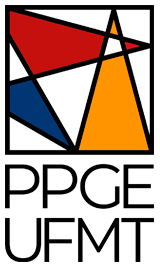A representação do corpo e do movimento humano nos discursos de crianças: um estudo transcultural
DOI:
https://doi.org/10.29286/rep.v22i49/1.914Palavras-chave:
Descrição do Movimento. Desenvolvimento. Cultura. InteraçãoResumo
Esse trabalho objetivou compreender como se desenvolve uma linguagem para o movimento humano. Participaram da pesquisa 103 crianças de sete e de dez anos do Brasil e da Inglaterra. A tarefa para um dos sujeitos era atravessar uma série de obstáculos de olhos vendados, seguindo as instruções de um parceiro sobre os movimentos a serem executados. Os resultados mostram diferenças significativas entre as crianças de sete e de dez anos de idade e entre as crianças de mesma idade, mas pertencentes a diferentes sistemas de educação no Brasil. Entretanto, poucas diferenças foram percebidas entre as crianças brasileiras e as inglesas.
Palavras-chave: Descrição do Movimento. Desenvolvimento. Cultura. Interação.
Abstract
The aim of this work is to understand how a language for human movement develops. Participated in the experiment 103 children aged seven and ten from Brazil and England. For one of the subjects, the task was to cross a series of obstacles while blindfolded, following the instructions of a partner on the movements to be performed during the crossing. The results show that there were significant differences between children aged seven and ten, and between children of the same age but from different education systems in Brazil. However, few differences were found between Brazilian and English children.
Keywords: Description of Movement. Development. Culture. Interaction.
Downloads
Referências
BLASING, Bettina; TENENBAUM, Gershon; SCHANK, Thomas. The
Cognitive Structure of Movements in Classical Dance. Psychology of Sport and Exercise, Journal of the European Federation of Sport Psychology, Amsterdam, v. 10, n. 1, p.350-360, 2009.
COX, Maureen. Children’sdrawings. London: Penguin Books, 1992.
DAVID, Kathryn Steyer. Motor sequencing strategies in school-aged children. Journal of the American Physical Therapy Association, Alexandria, v. 65, n. 6, p. 883-889, 1985.
DAVIS, Martha. The State of the Art: Past and present trends in body movement research. In: Wolfgang, A. (Ed.). Nonverbal Behavior: applications and Cultural Implications. New York: Academic, 1979.
DROMI, Esther. Early lexical development. Cambridge: Cambridge University Press, 1987.
EKMAN, Paul; FRIESEN, Wallace W.; TAUSSIG, Thomas G. Tools and methods for the automated analysis of visual records. In: GERBNER, G. et al. (Ed.). Content Analysis. New York: Wiley, 1969.
FREY, S.; POOL, L. A new approach to the analysis of visible behavior. Bern: University of Bern, 1976.
FREYD, Jennifer J. The representation of action. [commentary]. The Behavioral and Brain Sciences, Cambridge, n. 6, p. 145-146, 1983.
GENTNER, Dedre. Why noums are learned before verbs: Linguistic relativity vs. natural partitioning. In: KUCZAJ, S. A. (Ed.). Language development: language,
culture and cognition. Hillsdale, NJ: Erlbaum, p. 301-371, 1983.
GOODNOW, Jaqueline. Children’s drawings. London: Fontana/Open Books, 1977.
HIRSBRUNNER, Hans-Peter; FREY, Siegfried; CRAWFORD, Robert. Movement in Human Interaction: description, parameter formation and analysis. In: SIEGMAN, A. W.; FELDSTEIN, S. (Ed.). Nonverbal Behavior and Communication. London:
Lawrence Erlbaum Associates, 1987.
KOWALSKI, E. M.; SHERRILL, C. Motor sequencing of boys with learning disabilities: modeling and verbal rehearsal strategies. Adapted Physical Activity Quarterly, Champain, n. 9, p. 261-272, 1992.
LEDER, Drew. The absent body. Chicago: University of Chicago Press, 1990.
McCULLAGH, Penny; WEISS, Maureen; ROSS, Daine. Modeling consideration in motor skill acquisition and performance: an integrated approach. In: PANDOLF, K. (Ed.).Exercise
and Sport Sciences Review, Baltimore: Williams; Wilkins, p. 475-513, 1989.
MEICHENBAUM, Donald; GOODMANN, J. Training impulsive children to talk to themselves: a means of developing self-control. Journal of Abnormal Psychology,
Washington, n. 77, p. 115-126, 1971.
PIAGET, Jean; INHELDER, Barbel. Mental imagery in the child. London: Routledge and Kegan Paul, 1971.
PÚBLIO, N. S.; TANI, Go; JESUS, Edison Manoel. Efeitos da demonstração e instrução verbal na aprendizagem de habilidades motoras da ginástica olímpica. Revista Paulista de Educação Física, São Paulo, v. 9, n. 2, p. 111-124, 1995.
ROACH, NeilK.; BURWITZ, Les. Observational learning in motor skill acquisition: the effect of verbal directing cues. In: WATKINS, J.; BURWITZ, L. (Ed.).Sports
Science: proceedings of the VIII Commonwealth and International Conference on Sport, Physical Education, Dance, Recreation and Health. London: E. & F.N. Spoon,
p. 349-354, 1986.
ROSE, Debra J. A multilevel approach to the study of motor control and learning. Boston: Allyn & Bacon, 1997.
SHILLING, Chris. The body and social theory. London: Sage Publications, 2003.
SMITH, Mary M.; WING, Alan M.The psychology of human movement. London: London Academic Press, 1984.
TANI, Go. Significado, detecção e correção do erro de performance no processo ensinoaprendizagem de habilidades motoras. Revista Brasileira de Ciências & Movimento,
Brasília, DF, v. 3, n. 4, p. 50-58, 1989.
TARVER, Sara G. et al. Verbal rehearsal and selective attention in children with learning disabilities. A developmental lag. Journal of Experimental Child Psychology, Amsterdam, n. 22, p. 375-385, 1976.
VYGOTSKY, Lev Semyonovich. Thought and language. Cambridge: Massachusetts, 1963.
WALLON, Henri. As Origens do Pensamento na Criança. São Paulo: Editora Manole, 1989.
______. Do ato ao pensamento. Ensaio de psicologia comparada. Petrópolis: Vozes, 2008.
WEISS, Maureen R. Modeling and motor performance: a developmental perspective. Research Quarterly for Exercise and Sport, Essex, v. 54, n. 2, p. 190-197, 1983.
WERTSCH, James V. From social interaction to higher psychological processes. Human Development, Basel, n. 22, p. 1-22, 1979.
WOOD, David; BRUNER, Jerome S.; ROSS, Gail. The role of tutoring in problem solving. Journal of Child Psychology and Psychiatry, Reston, n. 17, p. 89-100, 1976.
WOOD, David. Como as crianças pensam e aprendem. Os contextos sociais do
desenvolvimento cognitivo. São Paulo: Edições Loyola, 2003.






















































